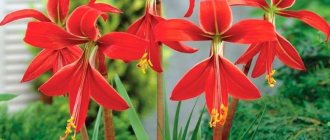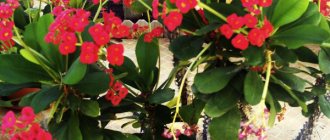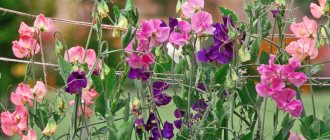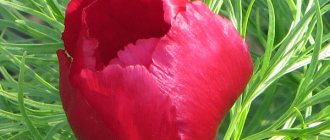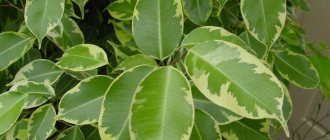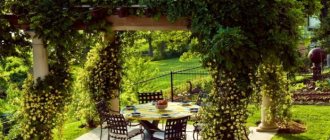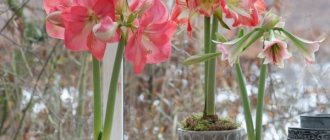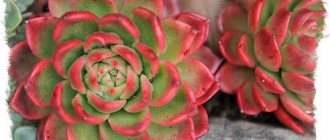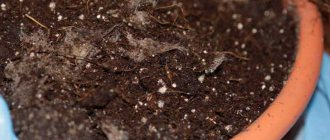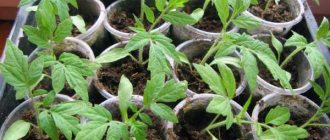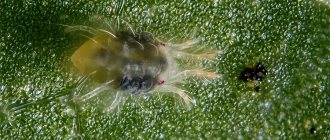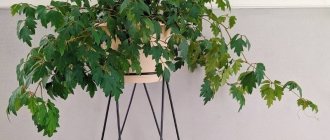- March 11, 2019
- Houseplants
- Marina Olenyuk
Surprisingly, even in our time, people tend to believe in various signs that have no scientific basis. One of these thoughts includes the fact that indoor vines, photos of which will be present in abundance in this article today, are capable of quarreling lovers and “surviving” any male creature from the house. Naturally, many consider this an unfair accusation against innocent plants.
Green pets, on the contrary, will clear the atmosphere of unfavorable elements and saturate them with oxygen, which is so necessary for any living creature. And if you really believe in something like that, then, for example, people who study energy flows have long told the world that all indoor vines (photos and names of flowers are attached) do not harm even at the energy level. On the contrary, all kinds of ivies with flowing thin stems and other climbing flowers expel all negative emotions from the room in which they settle. And such plants also perfectly purify the air and decorate the interior.
general information
Non-flowering and flowering indoor vines, the photos and names of which we will now get acquainted with, are climbing evergreens. Loaches are quickly able to cling to or wrap around a support. This property is achieved due to the peculiar growth of the stem. If desired, you can grow vines in the form of hanging crops. Then the plants will look like an attractive green waterfall.
But most often, flower growers independently wind flexible lashes onto special devices (rings, ladders), which flower shops abound in today, in order to direct the growth of shoots in the right direction.
It is preferable to plant plants with climbing and hanging shoots in hanging pots. This way you create a gorgeous “waterfall” of shoots and will not damage the stems when caring for the plant. Hanging baskets are difficult to reach for small children and tricky pets such as cats.
Lianas are indoor plants suitable for landscaping even those places in the apartment where other flowers feel uncomfortable. These may be corners of the room that are too shaded or, conversely, flooded with sunlight. Loaches are especially good for vertical decoration. Some non-flowering and flowering indoor vines perfectly decorate not the most attractive corners in the room.
Placing plants at home
One of the main points when keeping indoor loaches is their location and subsequently their shaped development. Most vines choose their own walls and hooks to cling to, but if you decide to help them with this, then such care will definitely not be superfluous. It is important to initially select the central branch and slowly weave it around various surfaces. If you want to give your vine splendor, then pinching twigs and shoots will come to the rescue.
When choosing a style and decor for your home or apartment, do not forget that climbing plants can be a wonderful addition to the interior. You can place one small flower arrangement near the sema indoors, or develop a beautiful climbing wall of plants of various types.
Well, now it's time to get inspired! In our album you can get acquainted with wonderful phyto-compositions!
Sun and water
As for caring for plants, they usually do not cause much trouble. Some difficulties, of course, may arise, but this is only in the case when you did not calculate and acquired a plant that is not quite suitable for your apartment. For example, the room faces north or west, and you purchased an indoor vine that loves sunny places. Or vice versa: the plant loves shade, but your room is illuminated by the bright scorching sun all day. Under these conditions, a plant that should grow in moderate shade will wither and become distressed with thin, pale stems and leaves. There are flowering indoor vines that, if placed incorrectly, will delight you with a gorgeous green mass, but you cannot expect flowers from them. Many are satisfied with this state of affairs, and the absence of buds is not considered something wrong. In addition, not all plants with beautiful leaves can please with equally beautiful flowering.
If you are still full of enthusiasm, then let's start getting acquainted with vines and ivies. The name and photo of indoor plants, as well as the conditions for keeping them, will help you make your choice.
Soil and replanting vines
If you bought a vine in a temporary pot, then within two weeks it will need to be transplanted to a permanent place of “residence”. It is better not to replant an indoor vine, but to transfer it with a clod of earth, so as not to injure the roots of the plant. And when replanting, try to hold the plant so as not to break the shoots. It is better to replant the vine with an assistant.
The soil for indoor vines needs to be fertile, but light, with a neutral or slightly acidic reaction. You can use a mixture of turf, humus and leaf soil. Or you can take ready-made mixtures: “Saintpaulia”, “Begonia”, “Cactus-plus”.
Some vines grow so low above the pot that the soil is not visible, but since they like loose soil, use a thin, long stick to loosen the soil in the pot.
As for feeding, vines need it, like other plants. If you fertilize them, they grow faster, and their leaves are juicier and thicker, and if you neglect feeding, the vines can “go bald.” As a fertilizer, you can use mullein diluted with water in a ratio of 1:10, or you can feed the vines with complex mineral fertilizer.
Hedera
Usually this plant is called simply - indoor ivy. This flower has carved delta-shaped leaves and strong creeping shoots. The plant is not considered difficult to care for. It likes moderate shade and moist soil. However, you should not overwater the hedera; a lump of soil that is too wet will destroy the plant.
This type of ivy has small growths on its stems. If the stem reaches a favorable place, then clinging roots appear from these growths. Ivy grows where this root falls. Be careful. If, having decided to get a hedera, you hang it next to it or place a pot with another plant, then the ivy will not behave very modestly. He can “reach” with a branch to the soil of a neighboring pot and “land” safely in it.
In nature, this plant entwines entire slopes of rocky hills and even the mossy walls of ancient houses. It grows very quickly and hides bare spots. If you need to decorate such a corner in your room as soon as possible, ivy will cope with this task and will not cause any difficulties.
Don't wait for the hedera to bloom. The plant produces buds only at a fairly advanced age (10-13 years). No room is conducive to such a long life of this ivy.
Transplantation is carried out only upon request
Only young vines should be replanted each year. The older and larger the plant, especially if it is formed on supports that are difficult to transfer to other containers, the less often it needs to be replanted, postponing this until the roots have completely mastered the substrate.
If the vines grow quickly, roots appear in the holes within a few months, and the plant itself does not tolerate containers that are too spacious, do not wait for a favorable period for replanting in the new spring, but replant then and as often as necessary, up to several times a year.
Passionflower. T. MA
Epipremnum or scindapsus
A perennial evergreen indoor vine valued for its leaves. They are quite dense and polished. The shape of the plate is close to heart-shaped. The foliage may be variegated or have a uniform green color. The length of thick stems increases to thirty centimeters per year. In general, epipremnum is capable of growing four-meter lashes.
A rather unpretentious specimen that thrives with moderate watering. This indoor vine, the photo of which is presented above, will delight you with its gorgeous foliage only if there is bright but diffuse lighting. Be careful with the plant, because it is quite poisonous. Therefore, you should only care for it with gloves. In addition, you need to keep the plant away from children and pets.
Advantages and disadvantages of weaving flowers
Climbing indoor plants are incredibly decorative.
Even if you don't have much space in your home, you can use the idea of placing plants vertically; they are perfect for this.
Many vines are shade-loving , and they can be used for spectacular decoration of hallways, walk-through rooms and baths.
Bindweeds look elegant in the design of modern offices, lobbies, reception areas and shopping centers. These plants perfectly purify the air. They absorb formaldehyde and other toxic compounds released by synthetic materials.
Some of them can also become a home first aid kit. For example, ivy has diuretic, anti-inflammatory, antifungal and antibacterial properties. A decoction of adiantum leaves will restore the beauty of your hair, ridding it of dandruff.
At the same time, some vines have poisonous sap, thorns and inedible fruits . Therefore, if there are children or pets in the house, you should think twice before purchasing a monstera.
There are many beliefs about which flowers should not be kept at home. The glory of muzhegons is assigned to all climbing plants. It is better for superstitious people to plant them in front of the entrance; then, according to popular belief, they lose this property and become amulets of the hearth.
Hoya
Often, beginning flower growers purchase scindapsus, which was discussed above, under the guise of Hoya. And all due to the fact that the plant has equally dense and wide leaves. Otherwise they are very different.
The second name of the flower is wax ivy. This is what people called hoya for its flowers and glossy leaves, covered with a waxy coating. There is hardly a person passionate about plants who, having once seen the buds of wax ivy, would not want such beauty for his collection. For some, flowering comes easily, and hoya pleases with clusters of waxy flowers almost continuously. And someone can hardly achieve the blossoming of one or two brushes.
The stems eventually reach a length of up to six meters. The plant tolerates both dry and humid air. Small flowers are collected in lush umbrellas. Some clusters (or umbels) contain up to fifty small buds with five sharp petals. The aroma emanating during the flowering of the beauty is dizzying in the literal sense of the word. It's very bright. Therefore, under no circumstances should a flowering plant be kept in places where people sleep. East windows are the best place to grow hoya. Here it has enough sunny color for rapid growth and lush flowering, and at the same time the foliage does not suffer from sunburn.
Gentle handling is the most important thing after transplantation
After transplanting, the home beauty is watered generously in small portions to evenly moisten the soil. The watering schedule is approached gradually. To avoid injury to the roots and slower growth, you should not add fertilizer for 1-1.5 months, since when transplanting there are enough nutrients in the soil that are so important for the plant.
Do not leave the vine near heating appliances, avoid direct exposure to sunlight. Air humidity should be high and be about 60%. When the plant adapts, check the condition of the leaves and new shoots and feel free to return the vine to its usual place.
Eschynanthus
Another interesting climbing flower with red flowers. It is not used very often in indoor gardening. Perhaps this happens because retail outlets offer aeschynanthus quite rarely. A very showy plant will feel great in a hanging pot. The shoots of the flower tend downwards and are decorated with bright red inflorescences. You can find flowers of aeschynanthus from red-orange to dark burgundy.
The stems grow up to half a meter. Over time, the older part becomes compacted and woody. The leaves of the vine are up to nine centimeters long. The flowers resemble tubes, narrowed on one side, and collected in inflorescences. The favorite part of the room for this plant is east and west. There is a lot of light and not too hot in the summer. During plant growth (spring - summer), water regularly. Before each subsequent moistening, it is worth checking the soil; the top layer should be dry.
List of climbing crops for home cultivation: name of the species, description and what it looks like in the photo
Cissus
A plant from the grape family, thanks to its spectacular leaves, fast growth and unpretentiousness, is very popular among gardeners. It also has other popular names: indoor grapes, birch, New Zealand grapes. Cissus can be grown as an ampelous plant or planted on special supports .
Flexible shoots grow up to 3.5 m. They say about cissus that it is a plant that walks on a mustache. When touching a solid object, the tendril forms a head, which, growing, takes the shape of a seal and, with the help of sticky juice, is firmly attached to the support.
There are more than 350 species of this genus of plants, but the most widespread in indoor floriculture are round-leaved, rhombifolia, antarctic and discolored with unusually decorative velvety leaves, a little like ivy leaves, painted in silver-white, green and burgundy colors.
Interesting! On the island of Java, cissus is called a plant source. The juice is carried along the long stems to the top with such force that, by cutting the stem, you can very quickly fill a glass with a cool drink.
Ivy
An evergreen vine of the Araliaceae family with numerous roots that attach to various objects. It usually grows quickly and can reach 30 m.
There are many varieties of the flower that climbs for growing at home, differing in shape, size and color of the leaves. One of the most spectacular varieties is cristata with corrugated rounded leaves of variegated or white color.
The healing properties of ivy have been known since ancient times. Its fresh leaves will help with burns or purulent wounds. And the alcohol tincture will help cope with hypertension and warts.
Interesting! For Christians, ivy is considered a symbol of eternal life and fidelity. The Egyptians considered it the plant of Osiris and also recognized it as a symbol of immortality. In Ancient Greece, it is dedicated to Dionysus (an ivy-covered pillar is one of his emblems).
Monstera
The liana of the Brazilian forests is famous for its fantastically rugged dark green leaves of enormous size. Its twisting stem with dark spots resembles a snake. It needs support, since the plant has a lightweight rhizome and can grow up to 3 m.
In damp rooms in cloudy weather, large drops of water, similar to tears, drip from the glossy leaves of monstera.
The plant cannot be grown in small rooms ; it requires comfortable space and good lighting.
Interesting! Monstera in Europe has long been considered a killer plant. The first travelers to South America were stunned by the aerial roots of giant vines hanging down and growing through the skeletons of people and animals. They mistook them for insidious tentacles.
The following is a photo of a variety of non-flowering crop called Monstera (Borziga):
Clerodendrum
A fabulously beautiful tropical plant of the Lamiaceae family. It also has the popular names tree of fate and innocent love. Unlike other climbing plants, it is believed to be able to bring happiness in your personal life.
More than 300 species are known, both deciduous and evergreen. They come in the form of trees, shrubs and vines. Of the vines, the most popular are Thomson's clerodendrum and Ugandan clerodendrum with blue butterfly flowers.
Nephrolepis
It is a terrestrial or epiphytic fern native to tropical forests. Among indoor flowers, it occupies a leading position in the beauty of dissected leaves and usefulness. It not only cleans, but also humidifies the air in the room.
Interesting! Wild relatives of Nephrolepis are the first to populate areas affected by volcanoes.
Maidenhair
Adiantum or Venus hair also belongs to the genus of ferns. Its name can be translated as a non-wetting plant. Its leaves are able to repel water.
Since ancient times in Europe, this plant has been used in the form of infusions and syrups as an antipyretic. It is used to treat the liver and bladder. In China, a decoction is prepared from the leaves of adiantum to help with alcohol addiction.
Hypocyrta: a flowering indoor crop with dense leaves
An exotic guest from South America of the Gesneriaceae family. Translated from Greek it means thickened at the bottom. The reason is the bright orange flowers that look like lips pursed for a kiss. No less decorative are the leaves, thickened in the form of an ellipse, the back of which is almost always purple. Any type of hypocyrta is an exquisite home decoration.
Due to the unusual shape of its flowers, it is also called the goldfish.
According to signs, having such a flower means profit.
Campanula
Abundantly flowering hanging plant of the bellflower family. The Mediterranean is considered its homeland. Its light green shoots droop under their own weight. Bell flowers come in a huge variety of colors, from snow-white to deep purple.
Campanula is considered a symbol of joy and family happiness.
There is a belief that if a flower does not bloom on time, then you can safely prepare for the wedding. People call it the groom (with blue flowers) and the bride (with white bells). Many people like to plant these two varieties in one pot.
Stephanotis: an unpretentious creeping vine
An evergreen herbaceous vine from the island of Madagascar with fragrant white star-shaped flowers is often called Madagascar jasmine.
The folk signs associated with it are absolutely contradictory. On the one hand, it is credited with the ability to drive away suitors, and on the other hand, in many countries, brides’ hairstyles are decorated with its flowers.
Monstera
A spectacular flower with huge carved leaf plates up to half a meter in length and width. At home, it is better to grow monstera in spacious rooms. The thick stem has many hanging roots. With them, the monstera masterfully clings to any bulges. For this reason, the plant must be provided with reliable and strong support. Loves moist soil and good, but not too bright light. The monstera reveals all its beauty in the fifth year of its life.
Syngonium
A representative of the Araceae family has green and variegated foliage. More often they prefer to plant variegated varieties. An adult specimen forms a bunch of roots under each of its leaves in the hope of clinging to a suitable support or to the soil. Diffused lighting and a temperature of 18–25 degrees Celsius are comfortable indicators for the vine. Watering is regular, but not abundant.
Propagating syngonium is not difficult. Each root located under the leaf blade, touching the moistened soil, grows safely, and a new young specimen is obtained.
A healthy vine starts with a quality substrate
Selecting soil for home vines is not difficult, the main thing is to adhere to several criteria. The soil should be: light, fertile, nutritious, loose, water- and breathable (in this case, a ready-made mixture - “Begonia” or “Cactus-plus”) is suitable); alternatively, use a turf mixture or humus. The composition of the substrate is selected according to the root system - light for young and thin roots, medium for fast-growing ones and heavy for large vines with large roots. It doesn’t hurt to add charcoal, ash, expanded clay, etc. to the soil for the purpose of disinfection. Good and high drainage in the pot will promote the development of the vine and help avoid many problems.
Mandevilla
The flower, although attractive, is capricious. The length of the shoots can reach four meters. The leaves are thick, shiny, pointed. The flowers of the vine are large and funnel-shaped, with five petals. They love this vine for its buds, each of which lasts up to ten days. The period when the capricious mandevilla pleases with flowering is also quite long.
Some varieties of these vines have a pleasant aroma. With proper care, flowering lasts from spring until late autumn. The plant does not tolerate cold at all. A temperature of 14 degrees can destroy the beauty. The rest of the care is quite prosaic: good light and properly regulated watering.
If mandevilla is trimmed regularly, it will grow into a lush bush covered in flowers. However, free-hanging plant vines are beautiful in their natural form.
Fast growing climbing plants
Every gardener wants to quickly decorate a garden plot or transform a fence, rather than wait years for a dense hedge to appear. To do this, you need to choose those plants that grow quickly.
Bougainvillea
This perennial loach came to us from Brazil. Breeders have received a large number of varieties to suit every taste.
Bougainvillea grows well in full sun and prefers regular watering. But he doesn’t like the cold; even at minus 5 degrees he can die.
In order for the vine to survive, it is removed in a warm room in the fall.
This plant should not be chosen to decorate a fence. To create a semblance of a hedge, you can place tubs with this plant near the fence. In tubs it is easier to put it away in a warm room for the winter.
Spiraea meadowsweet
Spiraea meadowsweet is a fast-growing shrub that will decorate any corner of the garden. It grows quickly and blooms very beautifully. But he loves good care. In dry summers it is necessary to water and feed frequently.
Cissus or indoor birch
A plant with such an interesting name (photo and description provided) is widespread and deservedly respected by flower growers. Cissus got its second name - birch - thanks to its leaves, or rather, their carved shape.
The indoor vine grows well, loves rich soil and spraying with settled boiled water. The leaves of the plant are dark and glossy. Unpretentious in care, cissus fits organically into any interior. Shaded areas of the apartment are suitable for the flower. And where other crops do not grow well, cissus feels great.
Doesn't like heat. For this vine it is more preferable to live in a cool place. If the cissus feels good, it will reward you with flowers and fruits - small inedible but beautiful balls.
The liana grows quite quickly. But in the first year of life, you need to have some patience, because the growth of the root mass helps the crop to slowly increase its green mass at the initial stage. The strong shoots of the vine can be left free; a waterfall of glossy leaves will give the place in which it grows the appearance of a wild corner of nature. The shoots feel great if you wrap them around any suitable support. In this way, you can direct the branches of the plant in a way that is convenient for the gardener.
Micro and macroelements are equally important
It is difficult to make a mistake when it comes to fertilizing for indoor vines: in order for the plant to receive all the nutrients it needs, it is enough to follow the instructions on the type of fertilizer, frequency and period of fertilizing. But when caring for indoor vines, one serious mistake is often made - they choose fertilizers, thinking only about the ratio of macroelements.
For plants with active growth of a large vegetative mass, microelements are no less important than nitrogen, potassium or phosphorus. If there are any signs of a lack of certain substances, additional fertilizing should be carried out immediately, and when choosing the type of fertilizer it is better to always give preference to preparations specifically designed for vines or complex complex formulations.
Calcium, which ensures the growth and formation of young shoots, magnesium, which allows maintaining the uniform beauty of colors, iron, which is also responsible for the growth and quality of leaves, as well as sulfur, copper, molybdenum, and manganese, are important for steeplejacks.
It is undesirable to use long-acting fertilizers for vines: the risk of uneven absorption of nutrients is much higher for them than for other indoor plants. It is better to reduce the concentration of fertilizers for steeplejacks, but carry out the procedures more often than applying high concentration fertilizers.
Raphidophora
Slowly but quite confidently gaining popularity in our country. All the sophistication of the plant lies in the feathery leaves. The flower quickly finds support and climbs almost any protruding area. Scourges can reach a length of 4.5 meters. Raphidophora needs pruning. Watering is infrequent. But it is necessary to moisten the leaves and air around the plant at least once every two to three days. Prefers diffused light. In winter, there comes a period when watering is reduced to once every ten days.
Individual approach
Each vine is unique and needs its own special care plan. And the easiest way to avoid mistakes is to document the procedure schedule and installation characteristics. A small sign or tag on the pot with general information about preferences, a moisture indicator, a log of fertilizing, watering and replanting is not only the best way to provide the plant with everything it needs, but also the easiest way to identify and analyze errors.
The choice of plant must be approached responsibly, and not rely only on impulse or appearance. Vines, even if they are elegant hanging plants, are plants that bring joy to the home for many years. Doing your research, checking the details provided by the seller, and assessing your options and your home based on your plant preferences will help you get off to a good start in using climbing plants. After observing the quarantine period, the plant quickly and painlessly adapts to the interior.
The most important aspect of the custom approach is pruning. This is done in accordance with species-specific recommendations and after careful analysis of the plant itself. But watering, fertilizing, replanting, and even choosing conditions should be carried out taking into account the requirements of a particular plant.
Scindapsus. Dennis Amit
Philodendron
Prized for the appearance of its leathery leaves. Depending on the type, their sizes can vary from 15 to 40 centimeters. Many types of philodendron are grown as hanging plants, but if you want a large, fast-growing vine, choose the ivy variety. In winter, at a temperature of +13 degrees, the plant has every chance of dying. Do not place the philodendron in drafts. Do not place in direct sun. But moderate lighting and the same humidity of the soil ball will contribute to the good development of the specimen. It will feel good if you occasionally spray it on the foliage with boiled water. Propagated only in the warm season by cuttings from the stem.
We hope the information about the most common types of indoor vines with photos and names was useful to you. And you were able to choose a plant that is ideal for your home conditions.
Blooming vines
Few types of climbing indoor plants bloom beautifully. We present the most common types.
Bougainvillea
Bougainvillea is native to Central America. About a dozen of its species are known. In countries with warm climates, such as the Mediterranean, it is a very popular garden plant, grown as a vine or small tree (depending on the type of pruning). Due to the lack of frost resistance in our country, bougainvillea is grown only as indoor plants.
The main decoration of bougainvillea is its colorful bracts that look like they were cut out of paper. Fully flowering plants are showered with flowers. Real flowers are invisible and barely visible. The color of the bracts varies: white, pink, yellow, red, purple. Many varieties are multi-colored. Bougainvillea leaves are leathery, 5 cm long, green. Some varieties have variegated leaves. Bougainvillea can be grown as vines or shrubs. When grown indoors, the plant is usually grown in the form of small vines (up to 2 m in length).
Bougainvillea loves sunny positions. It also grows well in partial shade, but blooms worse. Plants are ideal for sunny rooms with large windows and verandas. They reach large sizes. After a few years, the vines no longer fit on the windowsill. Therefore, it is worth placing them on stands with wheels to make it easier to transport them to the balcony or terrace in the summer.
Young bougainvilleas are replanted every year, old ones every few years. Recommended substrates are for flowering plants. At the bottom of the pot it is worth pouring drainage (expanded clay). This prevents root rot due to overwatering, especially in winter.
Bougainvillea is fed once every 2 weeks from April to July with preparations for flowering plants.
Interesting varieties of bougainvillea:
- "Afterglow" Afterglow - orange bracts with a yellow tint;
- “Double Red” Double Red – red bracts;
- "Jamaica White" Jamaica White - white bracts;
- “Rozenka” Rosenka – pink bracts;
- "Sasara" Sasara - peach bracts.
Hoya fleshy (Carnosa)
The hoya vine or carnosa (Hoya carnosa) is native to Asia. In nature, these are vigorous vines, reaching tens of meters. Withstands temperature changes, but is sensitive to frost. In apartments, Hoyas can climb other plants, trellises, furniture, blinds, cornices, and curtains. Watering: moderate (especially in winter).
Hoya is fleshy ornamental mainly with leaves. They are thick, leathery, lanceolate, 10 cm long, green, and there are variegated varieties. But hoya also has a unique decoration - small flowers (1 cm in diameter), shaped like stars, as if covered with wax. The flowers are collected in inflorescences, like baskets, and in the evenings they smell wonderful of cake.
The liana is undemanding and grows well, especially in rooms on the western and eastern sides. It tolerates shade well, but does not bloom in the shade. Reacts to turning the pot by lack of flowers. Great in living rooms, kitchens, and on stairs. You can also grow them in bedrooms, but the strong smell of flowers in the evening can make it difficult to fall asleep.
Hoya is replanted every 3-4 years; it needs to be provided with good soil. Place drainage at the bottom of the pot. Excess water, especially in winter, is the most common cause of vine rotting. Hoya pots should not be large. Fertilize the plant every 3-4 weeks from April to September. Hoya rosea does not require a dormant period, but its development will be well affected by higher temperatures in summer (22-24 °C) and lower temperatures in winter (approx. 15 °C).
Interesting varieties of Hoya:
- "Argentea" Argentea - white-green leaves;
- “Rubra” Rubra – green leaves with light spots;
- "Tricolor" Tricolor - creamy-green leaves, red shoots.
Passion flower blue
A beautiful and exotic liana with extremely original and decorative flowers - Blue Passionflower or Cavalier's Star, Blue Passionflower (Passiflora caerulea). Unfortunately, the plant has great requirements, so it will not grow well and bloom profusely everywhere (it needs fertile soil, a well-lit position, fertilizing during the growing season, fairly high temperatures in summer and dormancy in winter).
At home, it reaches a height of 3 m. The flowers grow singly in the axils of the leaves, have a diameter of 6-8 cm, and an original structure. They are blue-violet, and sometimes there are forms with pink or red flowers.
In summer it is worth taking the vine into the garden. If she stays in the room in the summer, she needs a lot of fresh air, the plant does not tolerate temperatures above 21 ° C, dry air in the apartment. The flower needs a lot of moisture, so it needs to be sprayed with cold water 2-3 times a week. In summer, we water the plants abundantly, every other day; in winter, watering is carried out every 7-10 days. It blooms better if the roots are not allowed to grow too much.
Eschynanthus
The Aeschynanthus flower is native to Asia. The most common species in our country have orange-red flowers. The plant requires a uniform temperature - 22-25 ºC, a semi-shaded position and high air humidity. In summer, it should be watered intensively, preventing the soil from drying out; it is also recommended to feed it with fertilizers for potted plants.
Esiquinanthus does not like direct sunlight; too much sun causes leaves to fall off. It needs permeable, loose, peaty soil with added sand, but will also grow in standard all-purpose potting soil.
The flower is replanted in the spring. Reproduction is carried out by cuttings. It is important to provide the seedlings with high temperature and humidity. Young seedlings are planted several in one pot, then during flowering the plant looks lush. At low air humidity, young shoots are affected by aphids and mealybugs.
Ideal for hanging flower arrangements. Blooms in summer. In the autumn-winter period, the plant goes into a dormant state, it is recommended to lower the temperature and limit watering. The flower does not like water with a high calcium content.
Stephanotis
Evergreen climbing stephanotis (Stephanotis) is a fast-growing indoor vine that can grow up to 4-5 meters. Blooms from spring to June, the flowers are white, very fragrant.
Stephanotis is a capricious, delicate plant that requires careful care. Grows well in a bright place, but not in direct sunlight. Loves a constant temperature of 20 °C (does not tolerate drafts). In winter there should be a lower temperature, but not lower than 13 °C. During the growth period, the substrate in the pot should be constantly slightly moist, but the plant cannot stand in water, otherwise it will begin to shed its leaves.
In summer, spray stephanotis leaves with soft water at room temperature and remove dust with a damp cloth. Shoots that are too long or lack leaves are pruned in the spring. Stephanotis flower buds may fall off due to:
- temperature fluctuations;
- plant movements;
- drying out or too much watering.
Stephanotis are excellent ornamental plants for home use. Their flowers are used by brides for wedding bouquets.
Gloriosa
An unusual liana from the Glorioza lily family. Its main decorative value is flowers. The genus Gloriosa includes many species characterized by cylindrical rhizomes. The stems reach a height of 1.5-2 m (they branch with age), oval, elongated leaves with thread-like tips are formed on them. Beautiful flowers, 8-10 cm long, appear from June to autumn.
The most famous species, Gloriosa rothschildiana, surprises with bright red, wavy flowers. Interesting species:
- Goriosa simplex (flowers initially yellow, then red);
- Gloriosa superba (green flowers turn yellow over time).
Gloriosis requires a warm, bright position, protected from direct sunlight. Optimal temperature: within 18-30 ºC. In the summer, you can move it to fresh air (terrace, balcony, garden), where it can remain until September. After flowering, the rhizomes go into a dormant state. The wintering place should be bright, warm and sunny. Leave it in the pot, do not water it, the substrate must be dry. Storage temperature in winter: 10-12 ºC.
In March, remove the old roots; if the rhizome is large, divide it and plant 2-4 tubers in fresh slightly acidic soil (pH 5-6). Plant evenly, covering with a 2-centimeter layer of soil. We water moderately, from the beginning of the growing season (the first buds appear) we spray the plant. It will require moderate fertilization during growth, once a week.
